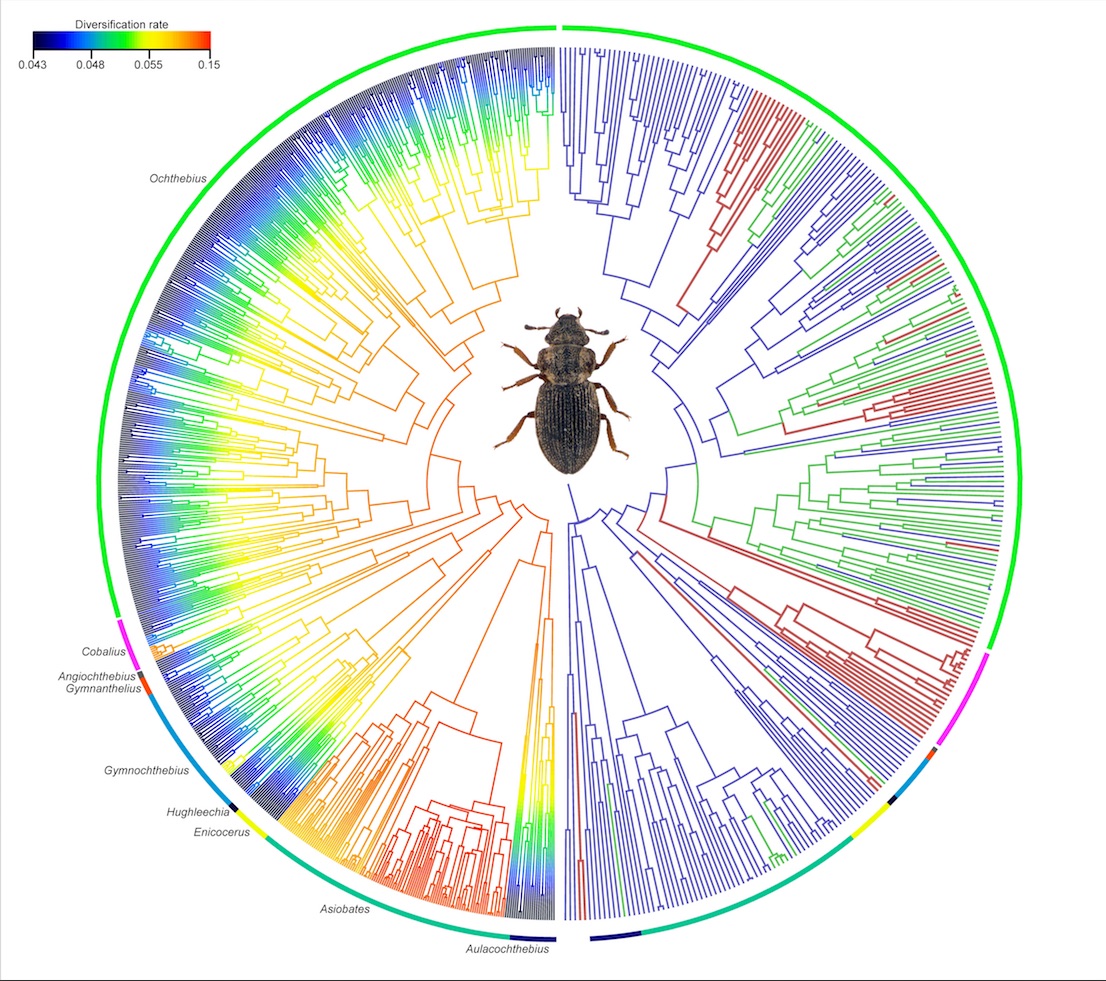Hypersaline aquatic habitats do not pose an evolutionary dead-end
A study led by researchers at the IBE confirms that hypersaline environments do not prevent aquatic beetle species from surviving, diversifying and even adapting to other environments.
The analysis, which includes more than 40 mitochondrial genomes of beetles of the genus Ochthebius, has revealed that they have acquired their tolerance to high salt concentrations gradually and repeatedly in different lineages during their 90 million years of evolution.
The posthumous work by Ignacio Ribera, published in the journal Molecular Ecology, could help understand the impact that climate change will have on aquatic species exposed to the increasing salinization and aridity of their habitats.

A research team at the Institute of Evolutionary Biology (IBE ), a joint centre of the Spanish National Research Council (CSIC) and Pompeu Fabra University (UPF ), and the Institute of Natural Products and Agrobiology (IPNA-CSIC), confirms that the extreme salinization of marine environments does not pose an evolutionary dead-end for aquatic beetles. The study could help understand the impact that climate change will have on the species that inhabit inland aquatic environments where salinization and aridity processes are already underway.
To date, one of the biggest question marks in the study of extreme ecological specialization has been to verify whether they lead to evolutionary dead-ends. The most widespread hypothesis holds that once species have reached an extreme degree of specialization to their environment, they lose their ability to survive in other environments or to adapt to small environmental variations, increasing their chances of extinction.
One such example of extreme ecological specialization is provided by hypersaline environments. Often, such environments have a salinity level up to four times higher than the average for seawater. These habitats represent one of the major stressors for aquatic organisms, since they involve physiological adaptations that allow them to deal with the toxicity of salts in the environment.
Now, researchers at the IBE and at the IPNA have studied the impact these hypersaline ecosystems have on the diversification of the species that inhabit them. “The main goal was to analyse whether ecological specialization to extreme environments represents an evolutionary dead-end as has been believed, or in other words, that once species have specialized to survive highly stressful environmental conditions, their survival, viability and adaptability are seriously compromised”, says Adrián Villastrigo, first author of the study who recently obtained his doctoral degree at the IBE in the group of the deceased Ignacio Ribera.
The study confirms that hypersaline environments do not prevent aquatic beetle species from surviving, diversifying, and even adapting to other environments.
To do so, the researchers studied aquatic beetles of the genus Ochthebius, the most diverse group of beetles found in hypersaline ecosystems. The team sequenced more than 40 mitochondrial genomes to reconstruct 90 million years of these insects’ evolution. The analysis of this information has also revealed that aquatic beetles became tolerant of high salt concentrations gradually and repeatedly in different lineages. And, thanks to an extensive review of the genus Ochthebius recently published (Villastrigo et al., 2019), it has been possible to complete the evolutionary history of the entire genus, since the analyses have been able to include all known species of the group.
The study could help understand the impact that climate change will have on the species that inhabit inland aquatic environments where salinization and aridity processes are already underway, and potential answers. The work completes the series of studies on how adapting to hypersaline environments has evolved in the main families of aquatic beetles led by the researcher Ignacio Ribera, who died this year (Arribas et al., 2014. Pallarés et al. 2017; Villastrigo et al., 2018).
Reference article: Adrián Villastrigo, Paula Arribas, Ignacio Ribera. Irreversible habitat specialization does not constrain diversification in hypersaline water beetles; 2020, Molecular Ecology. 29(19), 3637-3648
DOI: https://doi.org/10.1111/mec.15593
Cited articles:
Arribas, P., Andújar, C., Abellán, P., Velasco, J., Millán, A., & Ribera, I. (2014). Tempo and mode of the multiple origins of salinity tolerance in a water beetle lineage. Molecular Ecology, 23(2), 360-373.
Pallarés, S., Arribas, P., Bilton, D. T., Millán, A., Velasco, J., & Ribera, I. (2017). The chicken or the egg? Adaptation to desiccation and salinity tolerance in a lineage of water beetles. Molecular ecology, 26(20), 5614-5628.
Villastrigo, A., Fery, H., Manuel, M., Millan, A., & Ribera, I. (2018). Evolution of salinity tolerance in the diving beetle tribe Hygrotini (Coleoptera, Dytiscidae). ZoologicaScripta, 47(1), 63-71.
Villastrigo, A., Jäch, M. A., Cardoso, A., Valladares, L. F., & Ribera, I. (2019). A molecular phylogeny of the tribe Ochthebiini (Coleoptera, Hydraenidae, Ochthebiinae). Systematic Entomology, 44(2), 273-288.
